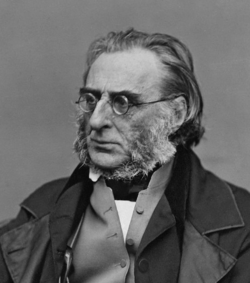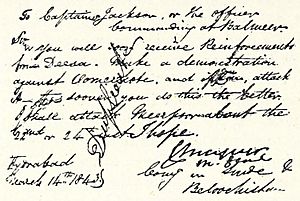Charles James Napier facts for kids
Quick facts for kids
Sir Charles Napier
|
|
|---|---|
 |
|
| Governor of Sindh | |
| In office 1843–1847 |
|
| Monarch | Victoria |
| Governor-General | The Lord Ellenborough Sir Henry Hardinge |
| Preceded by | New office |
| Succeeded by | Richard Keith Pringle As Chief Commissioner of Sindh |
| Personal details | |
| Born | 10 August 1782 Whitehall Palace, London, England |
| Died | 29 August 1853 (aged 71) Portsmouth, England |
| Resting place | Royal Garrison Church, Portsmouth |
| Awards | |
| Military service | |
| Allegiance | |
| Branch/service | British Army Bombay Army |
| Years of service | 1794–1851 |
| Rank | General |
| Commands | Northern District (1839–1840) Commander-in-Chief of India (1848–1849) |
| Battles/wars | Peninsular War War of 1812 Conquest of Scinde |
General Sir Charles James Napier (10 August 1782 – 29 August 1853) was a brave British Army officer. He fought in important wars like the Peninsular War and the War of 1812. Later, he became a Major General in the Bombay Army in India. He is famous for leading the capture of Sindh (now in Pakistan). After this, he served as the Governor of Sindh and then as the top military commander in India.
Contents
Early Life of Charles Napier
Charles James Napier was born in London at Whitehall Palace. His father was Colonel George Napier, and his mother was Lady Sarah Lennox. When Charles was only three, his family moved to Celbridge, Ireland. He went to school there.
At just twelve years old, in 1794, Charles joined the British Army. He didn't start fighting right away. Instead, he went back to school. In 1799, when he was 17, he began active service as an aide to Sir James Duff.
Fighting in the Peninsular War
Napier led the 50th (Queen's Own) Regiment of Foot during the Peninsular War in Spain and Portugal. This war was against Napoleon Bonaparte's French army. During the Battle of Corunna, Napier was badly wounded and left for dead.
A French drummer named Guibert found him and saved his life. Napier became a prisoner of war. Even so, he received an Army Gold Medal for his bravery. He was later released and went home to recover.
In 1810, Napier volunteered to return to the war. He fought in several more battles in Portugal and Spain. These included the Combat of the Côa, the Battle of Bussaco, and the Battle of Badajoz. In these battles, he had horses shot from under him. For his actions, he earned the Military General Service Medal.
Service in Bermuda and the War of 1812
After the Peninsular War, Napier served in Bermuda. His regiment, the 102nd, was stationed there in 1812. Bermuda was an important naval base for the British.
The War of 1812 started as his regiment left England. In 1813, Napier became second-in-command of a force. This force was tasked with raiding the American coast. They took part in the Battle of Craney Island. The war ended in 1814.
Later, Napier became the governor of Kefalonia in the Ionian Islands. He wrote a book about the island. He also went on a diplomatic mission to Greece during their War of Independence. He felt great sympathy for the Greek people.
Returning to England
In 1835, Napier was chosen to be the Governor of the new colony of South Australia. However, he decided to resign from the role. He suggested William Light for the job instead.
In 1839, Napier became the General Officer Commanding for the Northern District in England.
Leading the Northern District
As commander of the Northern District, Napier had to deal with many Chartist protests. The Chartists were a group who wanted more democracy. Napier actually agreed with many of their ideas.
He worked hard to keep things peaceful and avoid violence. He believed that the problems were caused by unfair government actions. Napier felt sorry for the Chartists rather than fearing them.
Service in India
In 1842, when he was 60, Napier was sent to India. He was made a Major General in the army there. He was ordered to stop a rebellion in Sindh Province (now part of Pakistan). The local Muslim rulers were against the British Empire.
Napier led his troops to victory in the Battle of Miani and the Battle of Hyderabad. He then took control of the entire Sindh Province. This was more than his original orders.
It is said that Napier sent a short, famous message to his superiors: "Peccavi". This is Latin for "I have sinned". It was a clever pun on "I have Sindh" (meaning he had conquered Sindh). This joke appeared in Punch magazine.
For his victories, Napier was made a Knight Grand Cross in the Order of the Bath in 1843. He also became the colonel of two different regiments.
Napier was appointed Governor of the Bombay Presidency. However, he often disagreed with the leaders of the East India Company. Because of these disagreements, he was removed from his position and returned home.
He was sent back to India in 1849 to deal with the Sikhs. But when he arrived, he found that Lord Gough had already defeated them.
Napier stayed in India as the top military commander for a while. He often argued with Lord Dalhousie, who was the Governor-General of India. Napier disagreed with Dalhousie's harsh methods, like punishing villagers who didn't pay taxes. He believed these actions were wrong and dishonorable.
Napier returned to England for the last time. He was still suffering from old war wounds. He died near Portsmouth on 29 August 1853, at age 71.
After his death, a book he wrote called Defects, Civil and Military of the Indian Government was published. In it, he criticized how the British treated Indian people. He wanted British officers to learn Indian languages and for Indian officers to be treated equally. He believed that Indian officers had great talent and ambition.
When a major revolt broke out in India in 1857, many people saw Napier's book as a warning that had come true.
Napier's former home is now part of Oaklands Catholic School. His remains are buried in the Royal Garrison Church in Portsmouth.
Napier's Legacy
Many things are named after Sir Charles Napier. In 1903, a military regiment was renamed the 125th Napier's Rifles in his honor. Today, it is part of the Rajputana Rifles.
There is a bronze statue of Napier in Trafalgar Square in London. Another marble statue is in St Paul's Cathedral. The statue in Trafalgar Square was put up in 1855. It was paid for by public donations, with many private soldiers contributing.
In 2000, the mayor of London, Ken Livingstone, suggested moving Napier's statue. He said he didn't know who Napier was. But the statue was not moved.
Napier's tomb is outside the west door of the Royal Garrison Church in Portsmouth.
The city of Napier in New Zealand is named after him. The suburb of Meeanee there remembers his victory in the Battle of Miani.
In Karachi, Pakistan (which is in Sindh), there used to be a Napier Road and Napier Street. There are also Napier Barracks and a Napier Mole in the port area. The St. Paul's Church in Manora is a memorial to Napier. Karachi Grammar School named one of its houses "Napier".
There is also a residential area called Napier Lines in Quetta, Pakistan. In India, the city of Jabalpur has a neighborhood called Napier Town.
See also
 In Spanish: Charles James Napier para niños
In Spanish: Charles James Napier para niños
- Colonel George Napier (1751–1804), his father;
- Lady Sarah Lennox (1745–1826), his mother;
and his brothers:
- Sir George Thomas Napier (1784–1855), Commander-in-Chief of the Army in the Cape Colony
- Sir William Francis Patrick Napier (1785–1860), soldier and military historian
- Henry Edward Napier (1789–1853), naval officer and historian.




